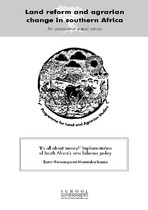| dc.contributor.author | Hersoug, Bjorn | |
| dc.contributor.author | Isaacs, Moenieba | |
| dc.date.accessioned | 2019-03-06T15:17:38Z | |
| dc.date.available | 2019-03-06T15:17:38Z | |
| dc.date.issued | 2001 | |
| dc.identifier.citation | Hersoug, B. & Isaacs, M., 2001. 'It's all about money! Implementation of South Africa's new fisheries policy. 16 ed. Cape Town: Institute for Poverty Land and Agrarian Studies (PLAAS). | en_US |
| dc.identifier.isbn | 1-86808-515-5 | |
| dc.identifier.uri | http://hdl.handle.net/10566/4366 | |
| dc.description.abstract | This paper was originally written as part of an economics study commissioned by the Chief Directorate: Marine and Coastal Management (MCM) of the South African Department of Environmental Affairs and Tourism (DEAT). Since the 1994 ‘negotiated revolution’, South Africa’s fishing industry has been under pressure to ‘become transformed’, just like most other industries and administrative institutions. The broad goals of the new dispensation were gradually spelt out, starting with an initiative in late 1994 which led to the establishment of the Fisheries Policy Development Committee (FPDC), via a White Paper on fisheries policy in 1997, and finally on to the passing of new legislation at the end of 1998 ñ the Marine Living Resources Act (MLRA). Although the Act is clearly a compromise between the existing industry owners and the political representatives of previously disadvantaged groups, it nevertheless opened a considerable ‘action space’ by insisting on ‘the need to restructure the fishing industry to address historical imbalances and to achieve equity within all branches of the fishing industry’ (MLRA section 2(j)). And reform was urgently needed. Just like the rest of South African society, the fishing industry was extremely racially skewed in terms of ownership of existing vessels and factories, as well as the allocation of quotas and fishing rights (Hersoug 1998; Hersoug & Holm 2000). The same pattern applied to industry leadership and fisheries administration ñ it was predominantly white. However, after years of discussions and planning, the high hopes pinned on implementing the proposed reforms have not borne fruit. More than two years after having passed the new MLRA, there is a high level of confusion about what is expected of the established industry and what is possible (in terms of redistributing quotas and fishing rights) for the new prospective entrants. In spite of having produced the long-awaited new framework for fisheries, production is falling, distribution conflicts seem to be endemic, litigation is becoming more common and huge human as well as economic resources are being expended on all kinds of ‘rent-seeking’ behaviour. What went wrong and why? | en_US |
| dc.language.iso | en | en_US |
| dc.publisher | Institute for Poverty Land and Agrarian Studies (PLAAS) | en_US |
| dc.relation.ispartofseries | Land reform and agrarian change in Southern Africa;18 | |
| dc.subject | South Africa | en_US |
| dc.subject | Fisheries | en_US |
| dc.subject | Fisheries policy | en_US |
| dc.title | 'It's all about money! Implementation of South Africaís new fisheries policy | en_US |
| dc.type | Book | en_US |

